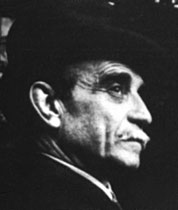He was born on February 19th 1899 in Rosario, Santa Fe. When his was six years old, he moved with his family to Milan, where he followed technical studies. In 1922, he returned to Argentina and worked in his father's workshop, devoted especially to funereal sculpture. Towards the end of the decade, he returned to Italy where he became Adolph Wildt's student at the Brera Academy.
In 1934, he carried out some experimental works using thin biface structures, which were exhibited in 1935 at the Primera muestra colectiva de arte abstracto italiano (First group exhibition of Italian abstract art) presented in Turin. That same year, he joined the Abstraction-Creation. Art non figurative group based in Paris.
He produced a project for the International Competition for the Monument to General Julio A. Roca and, in December 1936, he joined the Lombard abstract group that exhibited abstract drawings and engravings at Galería Moody in Buenos Aires.
During World War II, he settled in Buenos Aires, carried out the monument El sembrador (The Sowe), for the city of Rosario and worked as a sculptor on the project for the National Monument to the Flag and for the Monument to General San Martín to be placed in Quilmes, Province of Buenos Aires. During his time in Argentina, he held exhibitions at Galería Müller, Impulso, at the Museo Municipal de Santa Fe and he participated in group exhibitions and art salons. He taught at the Escuela de Artes Plásticas in Rosario, the Escuela de Bellas Artes “Prilidiano Pueyrredón”, the Escuela de Bellas Artes “Manuel Belgrano” and at the Escuela Libre de Artes Plásticas Altamira, an institution that he organised together with Emilio Pettoruti, Jorge Romero Brest and Jorge Larco.
Although his Argentine production until 1946 shows a visible figurative tone, he and his young students worked on new ideas, from which, between October and November 1946, the Manifiesto Blanco (White Manifesto) evolved, written by Bernardp Arias, Horacio Cazenueve and Marcos Fridman and signed by a larger group of colleagues. Possibly because of his ties with the official institution, Fontana did not sign this document that supported the idea of "surpassing painting and sculpture to accede to a new art of matter, colour, sound and movement".
In 1942, he obtained the First Sculpture Prize at the XXXII Salón Nacional. In 1945, he joined the Salón Independiente (Independent Salon), convened by artists opposed to the Salón Nacional.
On returning to Italy, he settled back in Milan, where he signed the I Manifiesto Espacialista with the participation of Giorgo Kaisserlian, Beniamino Joppolo and Milena Milani, which states that "art work is subject to destruction in time […] An aerial expression of art in a minute, is as if it had lasted a millennium in eternity. To this end, with the resources of modern technology, we shall make artificial forms, rainbows of wonder, luminous signals in the sky".
In March 1948, he, along with Kaisserlian, Joppolo, Milani and Antonio Tullier, signed II Manifiesto del Espacialismo and presented Escultura especial (Space Sculpture) at the Venice International Art Biennial. The following year, he created Ambiente especial con luz negra (Spatial Environment with black light) at Galleria del Naviglio, and then, deepening his spatial quest within the pictorial scene, he produced the first "holes".
In 1950, he signed the III Manifiesto del arte espacial: Propuesta de un reglamento (III Manifesto of spatial art: Proposal of a regulation), together with Milani, Joppolo, Roberto Crippa, Giampiero Giani and Carlo Cardozzo. That same year, he participated in the International Modern Drawing Exhibition held in Bergamo and in the competition for the fifth door of Milan Cathedral. In November 1951, he signed the IV Manifiesto de Arte Espacial (IV Manifesto of Spatial Art).
Later, he worked on the "Stones" series (works with the application of glass), followed by "Inks" and "Papers". In 1959 he exhibited the “Tajos” (Slashes) series at Galleria del Naviglio and at Galerie Stadler in Paris, in which he aimed at the physical rupture of the pictorial plane.
In 1964, Enrique Crispolti organised a "Tribute to Fontana", as part of the international Aspetti dell'arte contemporanea review and, in 1966, the Museum of Modern Art of New York hosted the itinerant exhibition Alberto Burri and Lucio Fontana.
In Argentina, mention should be made of the exhibitions presented at the Instituto Torcuato Di Tella in Buenos Aires (1966) and at the Museo Municipal “Juan B. Castagnino” in Rosario (1966).
Fontana worked on his oils, holes and slashes in the old family house in Comabbio until his last days.
He died in Varese, Italy, on September 7th 1968.
